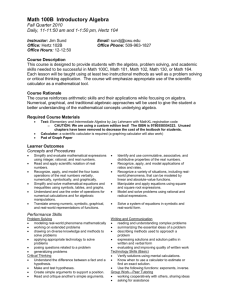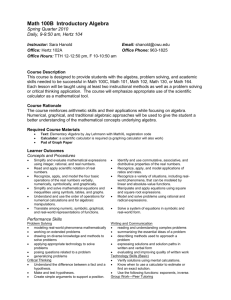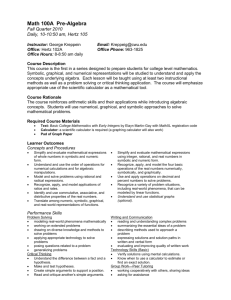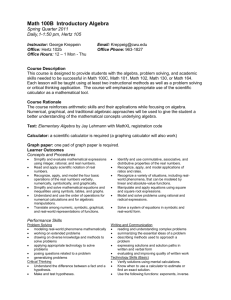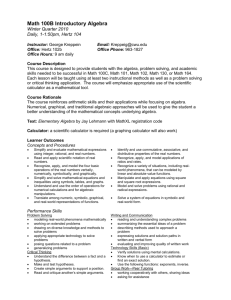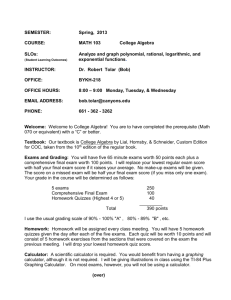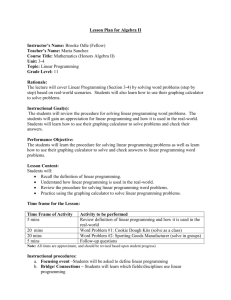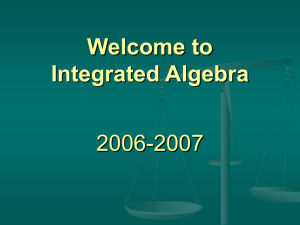Math 100B Introductory Algebra
advertisement
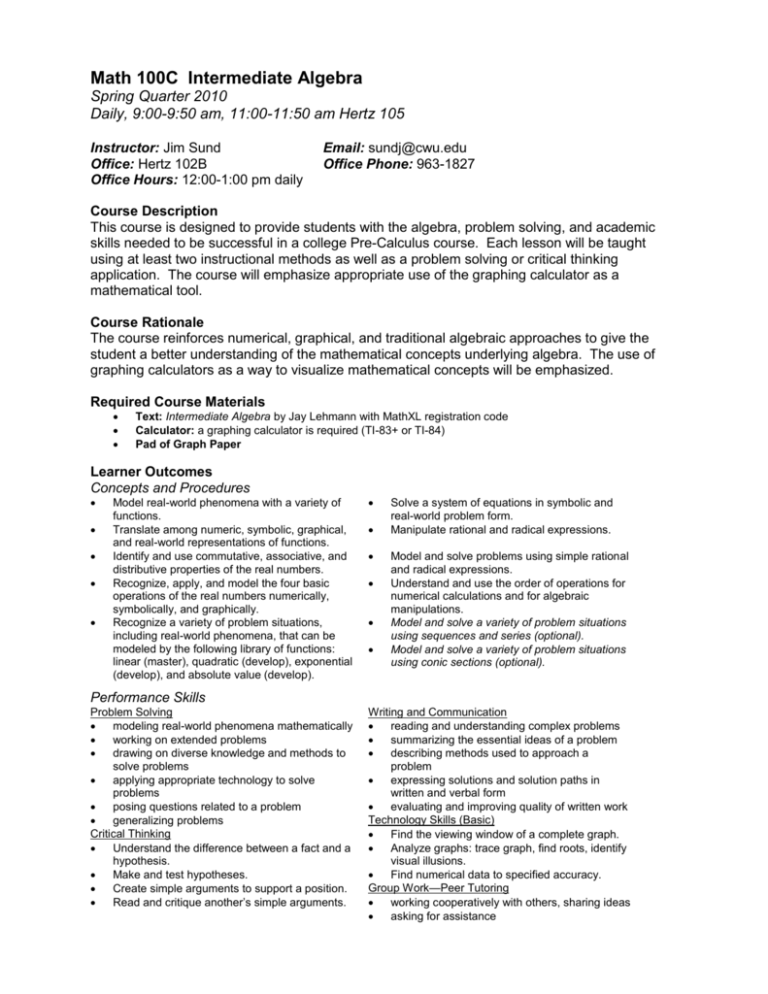
Math 100C Intermediate Algebra Spring Quarter 2010 Daily, 9:00-9:50 am, 11:00-11:50 am Hertz 105 Instructor: Jim Sund Office: Hertz 102B Office Hours: 12:00-1:00 pm daily Email: sundj@cwu.edu Office Phone: 963-1827 Course Description This course is designed to provide students with the algebra, problem solving, and academic skills needed to be successful in a college Pre-Calculus course. Each lesson will be taught using at least two instructional methods as well as a problem solving or critical thinking application. The course will emphasize appropriate use of the graphing calculator as a mathematical tool. Course Rationale The course reinforces numerical, graphical, and traditional algebraic approaches to give the student a better understanding of the mathematical concepts underlying algebra. The use of graphing calculators as a way to visualize mathematical concepts will be emphasized. Required Course Materials Text: Intermediate Algebra by Jay Lehmann with MathXL registration code Calculator: a graphing calculator is required (TI-83+ or TI-84) Pad of Graph Paper Learner Outcomes Concepts and Procedures Model real-world phenomena with a variety of functions. Translate among numeric, symbolic, graphical, and real-world representations of functions. Identify and use commutative, associative, and distributive properties of the real numbers. Recognize, apply, and model the four basic operations of the real numbers numerically, symbolically, and graphically. Recognize a variety of problem situations, including real-world phenomena, that can be modeled by the following library of functions: linear (master), quadratic (develop), exponential (develop), and absolute value (develop). Solve a system of equations in symbolic and real-world problem form. Manipulate rational and radical expressions. Model and solve problems using simple rational and radical expressions. Understand and use the order of operations for numerical calculations and for algebraic manipulations. Model and solve a variety of problem situations using sequences and series (optional). Model and solve a variety of problem situations using conic sections (optional). Performance Skills Problem Solving modeling real-world phenomena mathematically working on extended problems drawing on diverse knowledge and methods to solve problems applying appropriate technology to solve problems posing questions related to a problem generalizing problems Critical Thinking Understand the difference between a fact and a hypothesis. Make and test hypotheses. Create simple arguments to support a position. Read and critique another’s simple arguments. Writing and Communication reading and understanding complex problems summarizing the essential ideas of a problem describing methods used to approach a problem expressing solutions and solution paths in written and verbal form evaluating and improving quality of written work Technology Skills (Basic) Find the viewing window of a complete graph. Analyze graphs: trace graph, find roots, identify visual illusions. Find numerical data to specified accuracy. Group Work—Peer Tutoring working cooperatively with others, sharing ideas asking for assistance Guidelines for evaluating and assessing the student’s ability to meet the learner outcomes. Student Advancement Passing this course requires satisfactory performance in the areas of scholastic behavior, coursework, and basic skills. Students must meet the following standards: No more than 6 absences and/or missed assignments (excused absences must be permitted by the director). 73% or better on coursework (including a passing grade on the final). Successful completion of Basic Skills tests. Coursework The coursework will consist of homework, projects, quizzes, and exams. Homework will require the use of MathXL. Projects will involve a written component. Mastery of Basic Skills The Basic Skills tests cover skills that students are expected to know when entering the course. Students must pass both Basic Skills tests at an 80% proficiency level. Students may retake these tests in order to meet the required proficiency level. Dates will be announced. Final Exam A comprehensive final exam worth 20% of the final grade will be given at the end of the quarter covering all of the course’s learner outcomes. The content and type of questions will be similar to quizzes and exams given during the quarter. Grading Grades will be determined by the following weights: Homework 20% Exams 60% Final Exam 20% Grades will be determined by the following scale: 93-100% = A 90-93% = A - 87-90% = B + 83-87% = B 73-77% = C 70-73% = C - 67-70% = D + 63-67% = D 80-83% = B 60-63% = D - 77-80% = C + Below 60%=F Support Services A drop-in lab is available for students who need help on their coursework. Additional tutoring support may be offered to students who require it—talk to your instructor for more details. Students who have special needs or disabilities that may affect their ability to access information and/or material presented in this course are encouraged to contact the office of Disability Support Services on campus (963-2171). Joke Day Wednesday- tell a joke and earn a point. (Huskies jokes are worth two points) Ability<Attitude<Work Ethic If it’s to be, it’s up to me!
